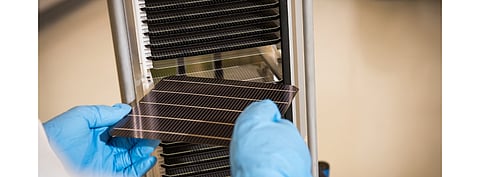

Around 2 years back, Oxford PV achieved 28% efficiency for perovskite-silicon tandem cell with NREL certifying the record for this type of solar cell (see 28% Efficiency For Oxford PV Perovskite Cell). In 2020, Germany's Helmholtz Zentrum Berlin (HZB) surprisingly challenged the leader in this field, taking away the record with a 29.15% efficient cell (see Perovskite Tandem Cell 29.15% Efficiency Record). Now Oxford PV has fought back, re-claiming the world record efficiency for tandem silicon-perovskite tandem cells. The 29.52% efficiency by Oxford PV is again certified by NREL.
Explaining the technology used by its team for this 'record-breaking' cell, Oxford PV says it coated the ordinary silicon solar cells with a thin film of the material perovskite to better utilize photons across the solar spectrum. It claims this synthetic perovskite material is affordable, sustainable and eventually could replace silicon entirely. For comparison, 35 kg of perovskite generates same amount of power as 7 tons of silicon.
"We are currently at a global tipping point – climate change is dramatically worsening and the need to use alternative forms of energy has never been greater. Our solar cells are critical in accelerating the adoption rate of solar and tackling the ever-worsening issue of climate change," said Oxford PV CEO Frank P. Averdung. "We have a clear roadmap to take this technology beyond 30%."
Exceeding the 30% milestone is also the target that HZB researchers are aiming for as they explained in a research paper published recently about their 29.15% efficiency record, that they were able to analyze the 2 sub-cells individually and calculated a maximum possible efficiency of 32.4% that can be achieved with exactly this structure (see HZB Team Aiming To Exceed 30% Tandem Cell Efficiency).
Oxford PV has been aiming to enter mass production for its perovskite-silicon tandem solar cell technology with Meyer Burger supplying its production equipment. It is now targeting 2022 as the year when the commercial launch will happen with initial products from its Brandenburg, Germany located factory, available for residential rooftops.
The State of Brandenburg approved €8.8 million funding amount for the company to expand its operating facility here that has been producing high efficiency silicon perovskite solar cell on a pilot production line installed (see Brandenburg Commits €8.8 Million For Oxford PV Expansion).
At its recent High Efficiency Solar Cell Conference, TaiyangNews also covered the topic of crystalline silicon based tandem solar cells. A recording of TNO/UNSW's Dr. Gianluca Coletti's Next Generation Tandem Solar Cell Technologies presentation can be viewed here.
.png?w=50&fm=png)